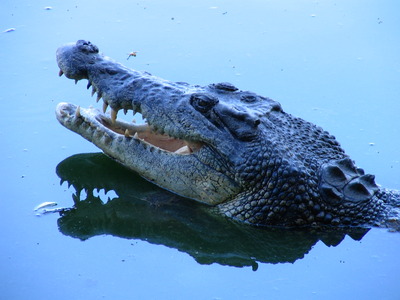Completion of saltwater crocodile genome sequence will help commercial breeders
The genome sequence of the crocodile has been completed by an international collaboration of scientists, including researchers from the University of Sydney.

The team from the university will develop information from the sequencing to perfect crocodile breeding techniques - a development of enormous potential benefit to the crocodile industry in Australia, which is worth an estimated $8.8 million in exports.
“We had previously completed a genome map for the saltwater crocodile but this is a huge leap forward,” said Professor Chris Moran from the University’s Faculty of Veterinary Science.
“Genome sequencing is the next step. The difference between genome mapping and genome sequencing is the difference between having a map of Australia on a single page and a detailed street directory.”
Advances in DNA sequencing technology, so-called nextgen sequencing, have provided between one thousand and ten thousandfold reductions in cost, and comparable increases in the speed with which whole genome sequences can be generated.
“It cost many millions of dollars and many years of work by a huge international collaboration to produce the first human genome sequence in 2002,” Professor Moran said.
“Now a complete genome sequence can be produced for a complex organism for several thousands of dollars and in a relatively few months of work; this is what has been achieved with the finalisation of the saltwater crocodile genome sequence.”
Crocodiles do not become sexually mature until they are seven years old, which means that currently breeders have to wait that long before they can choose suitable breeding stock.
“The genome sequencing revolutionises that process,” Professor Moran said.
“So the Darwin Crocodile Farm, one of our industry partners, will be able to take DNA samples as soon as the crocodiles hatch and use them to decide which animals will be suitable for breeding.
“This is possible because the genome sequence identifies genetic ‘markers’ which provide information on the likely health and breeding quality of an animal.”
Professor Moran worked on the genome sequence with his University of Sydney colleague Dr Jaime Gongora, PhD students Amanda Chong and Pauline Dalzell, and research affiliates (and former PhD students of the university) Dr Sally Isberg and Dr Lee Miles. They have been working on the genetics and genomics of farmed saltwater crocodiles since 2001 with funding from the Rural Industries Research and Development Corporation.
Other outcomes of the genome sequencing work include a better understanding of the evolutionary relationships among crocodylians, especially between the alligator family and crocodile family. It will also improve our understanding of crocodylians’ relationships to other reptiles including their closest living relatives, the birds.
Blood test could be used to diagnose Parkinson's earlier
Researchers have developed a new method that requires only a blood draw, offering a non-invasive...
Cord blood test could predict a baby's risk of type 2 diabetes
By analysing the DNA in cord blood from babies born to mothers with gestational diabetes,...
DNA analysis device built with a basic 3D printer
The Do-It-Yourself Nucleic Acid Fluorometer, or DIYNAFLUOR, is a portable device that measures...



